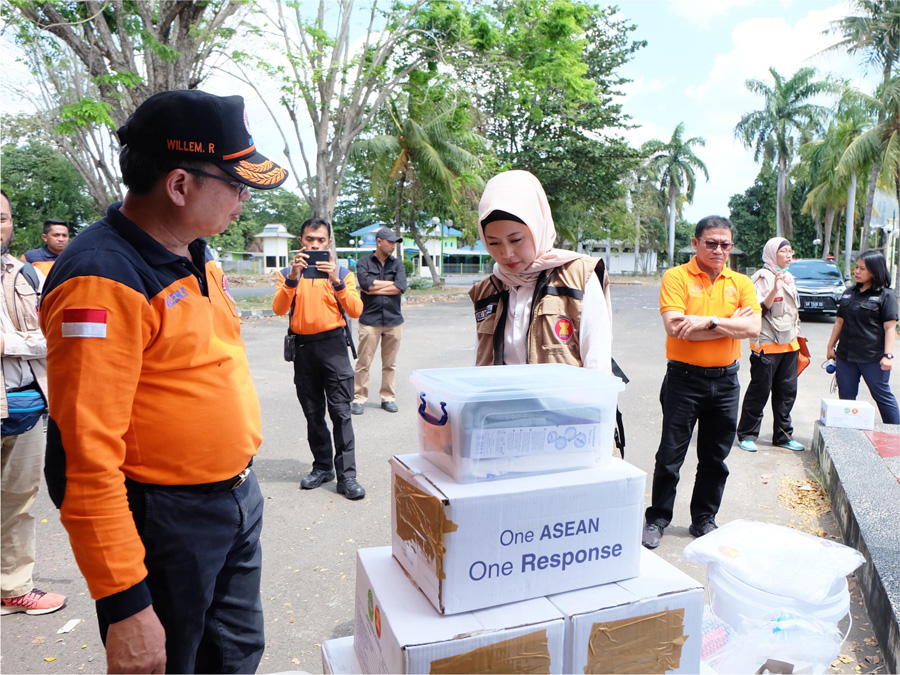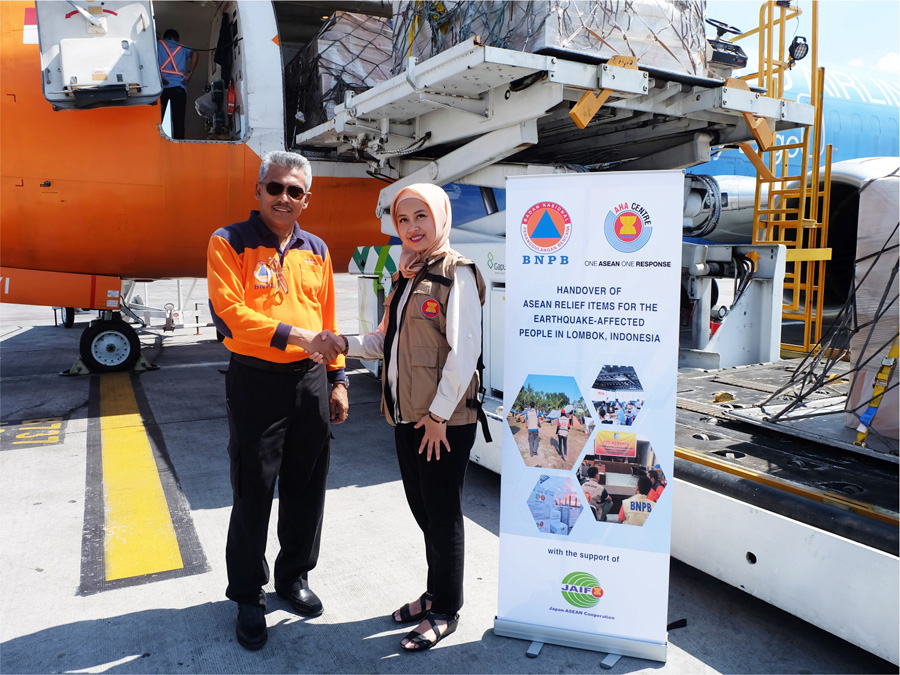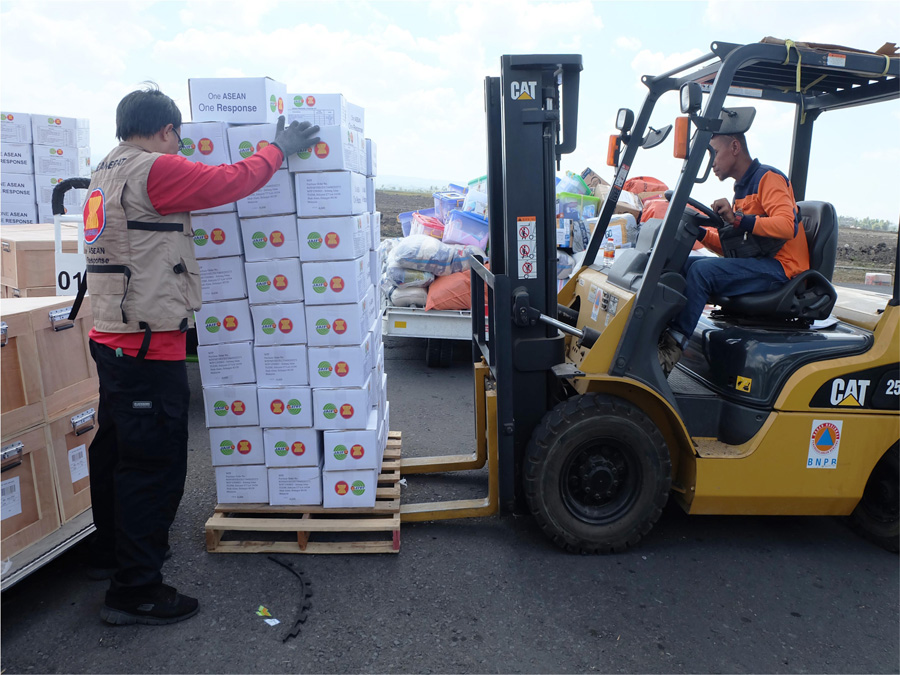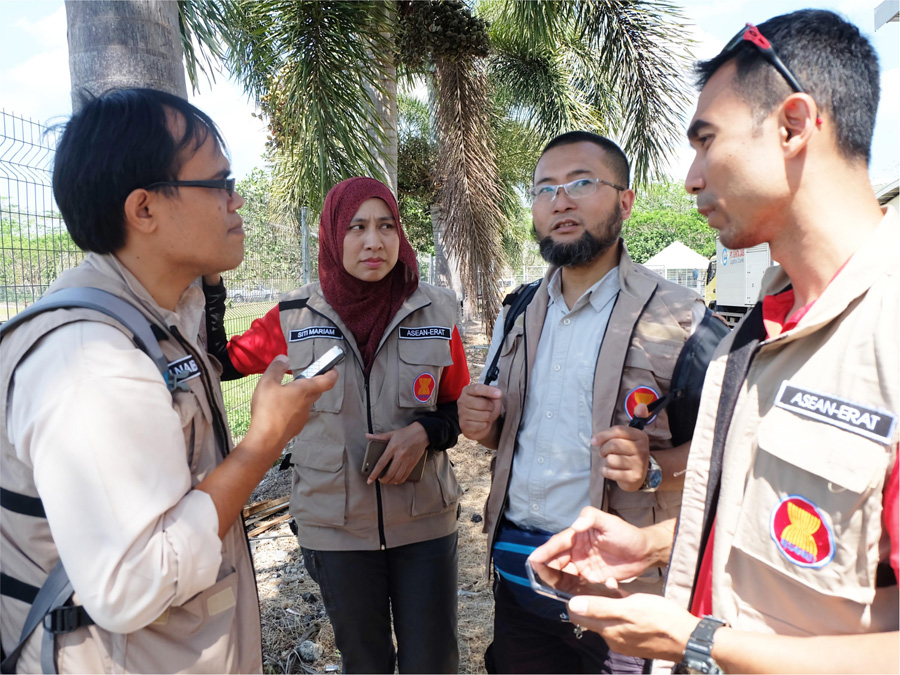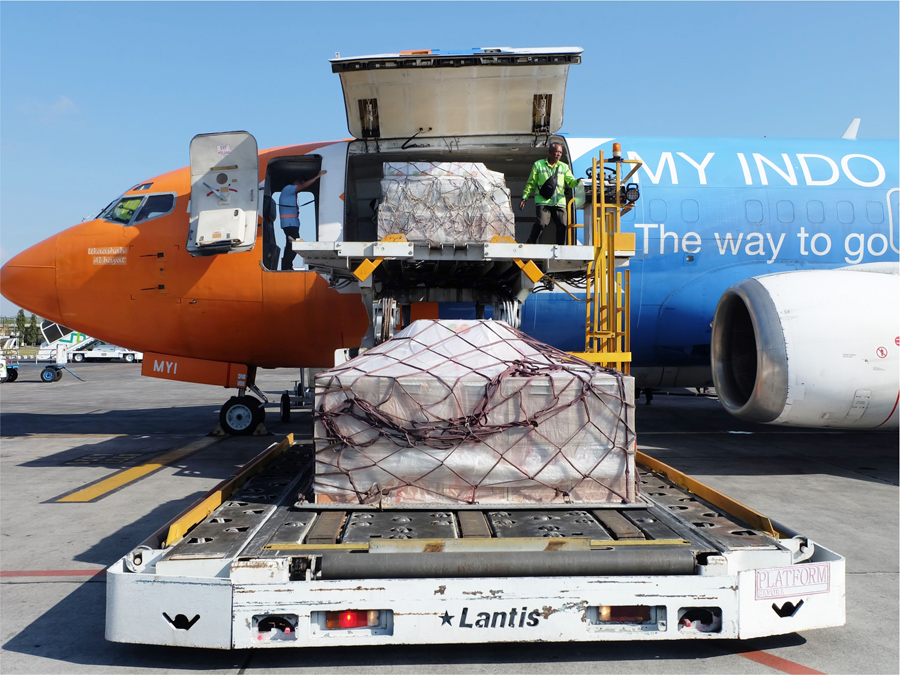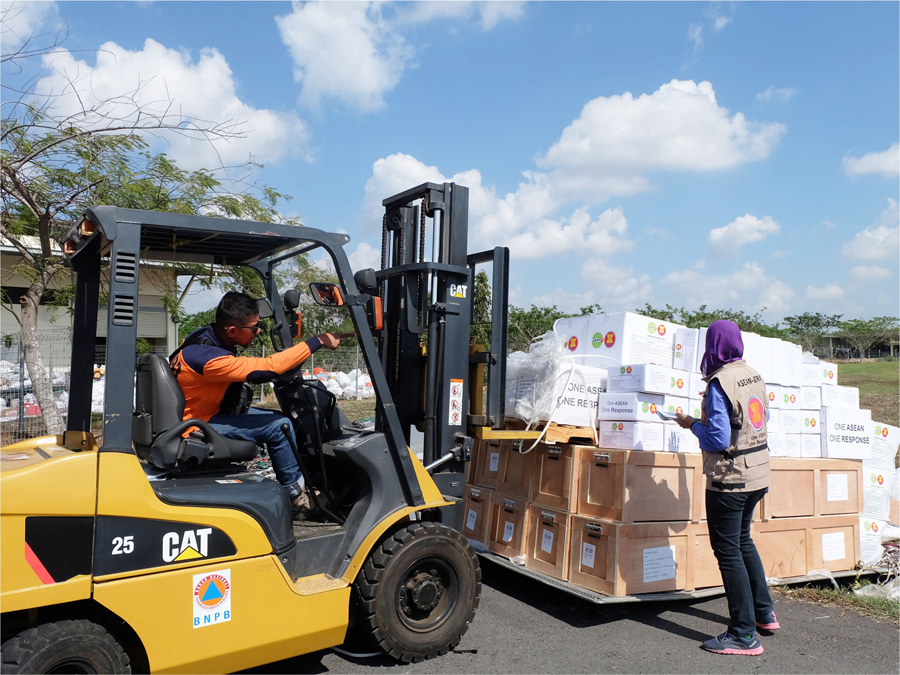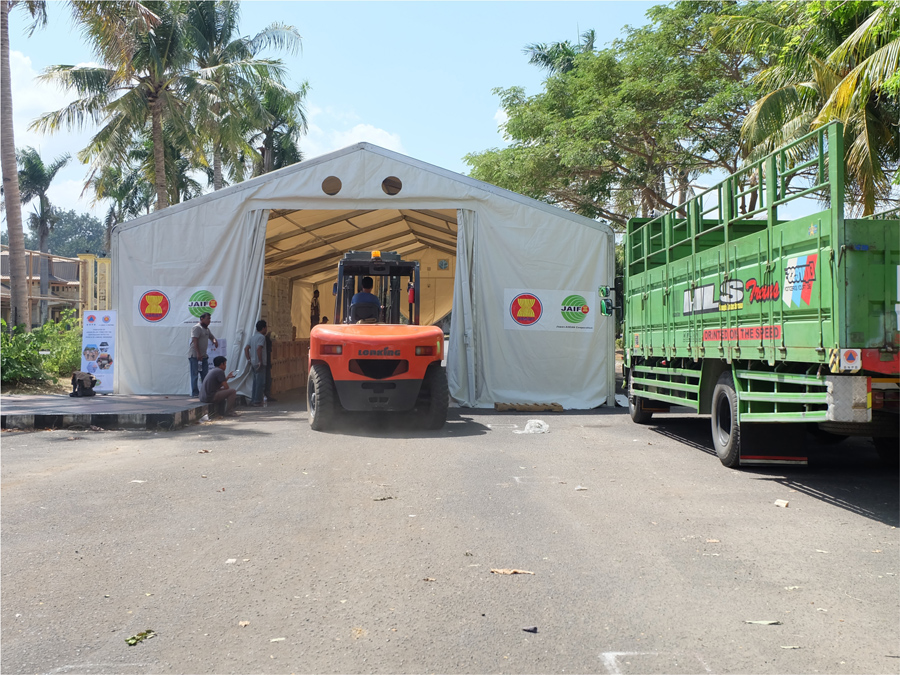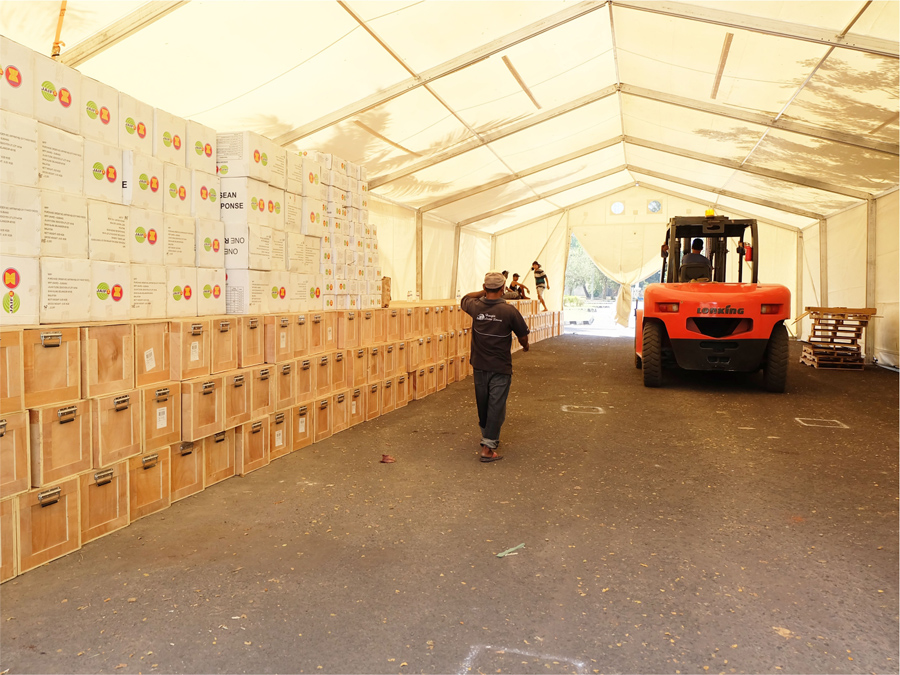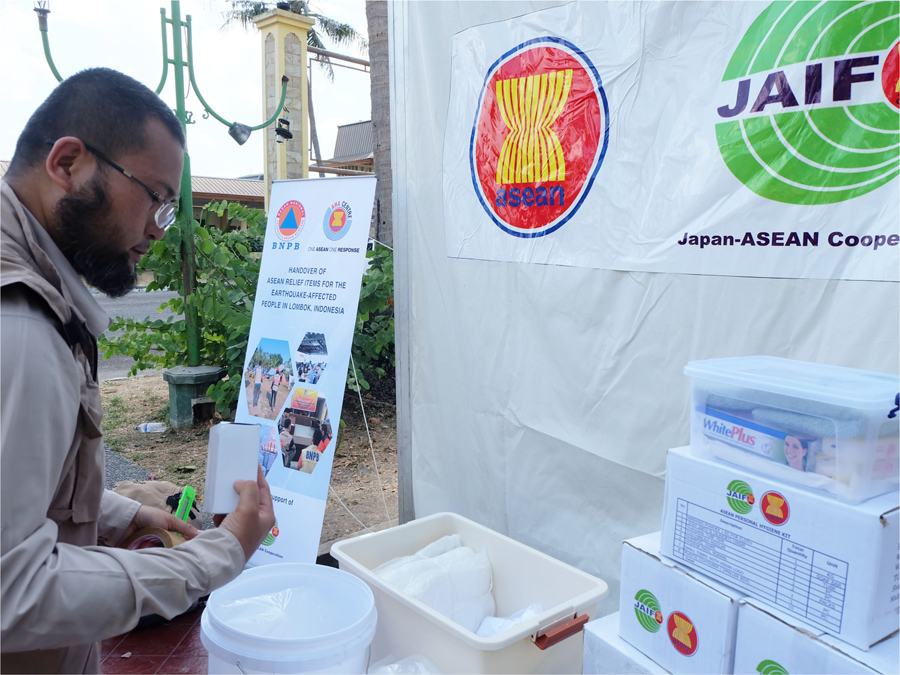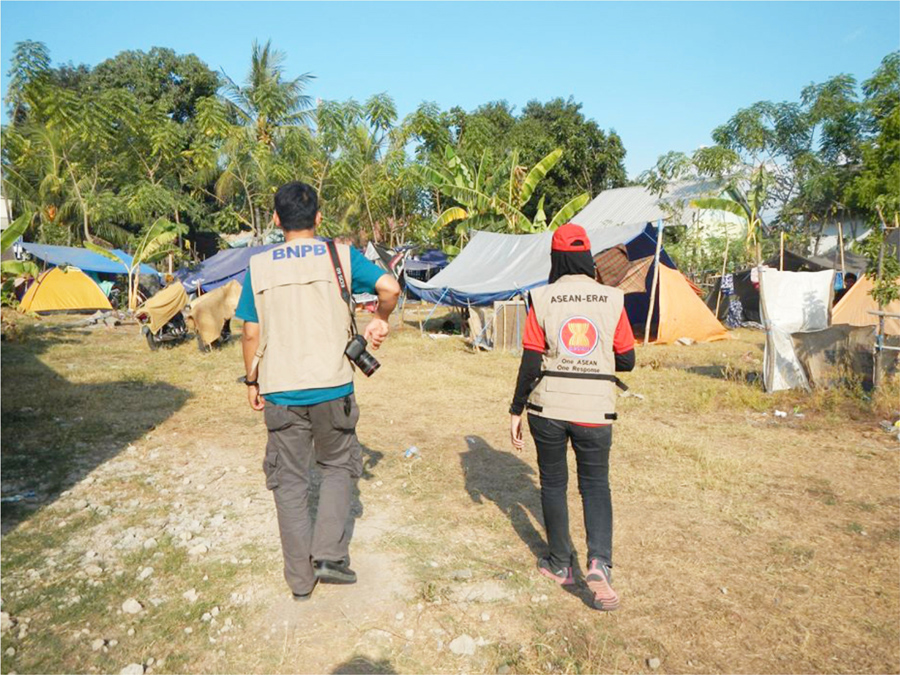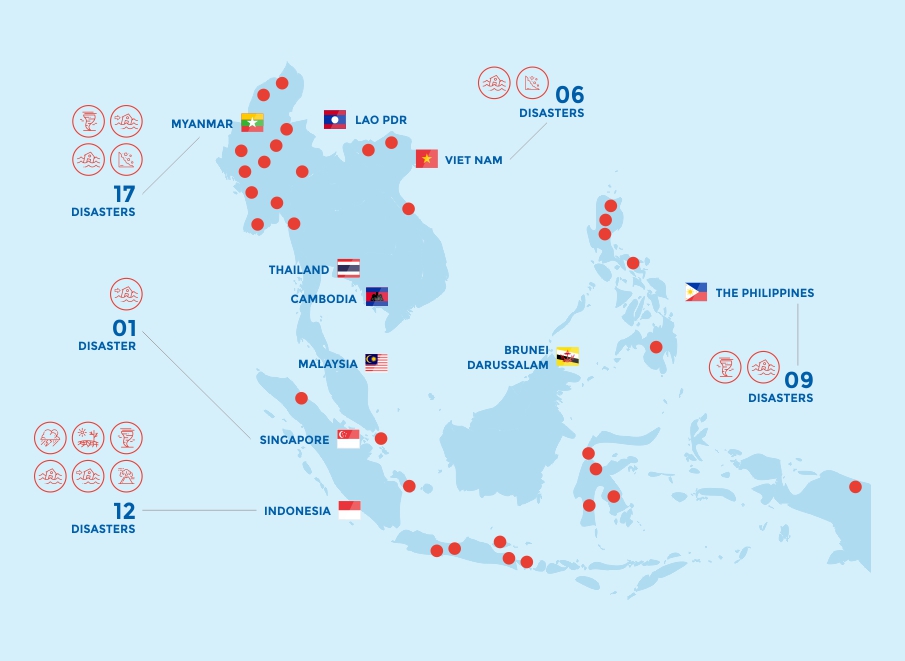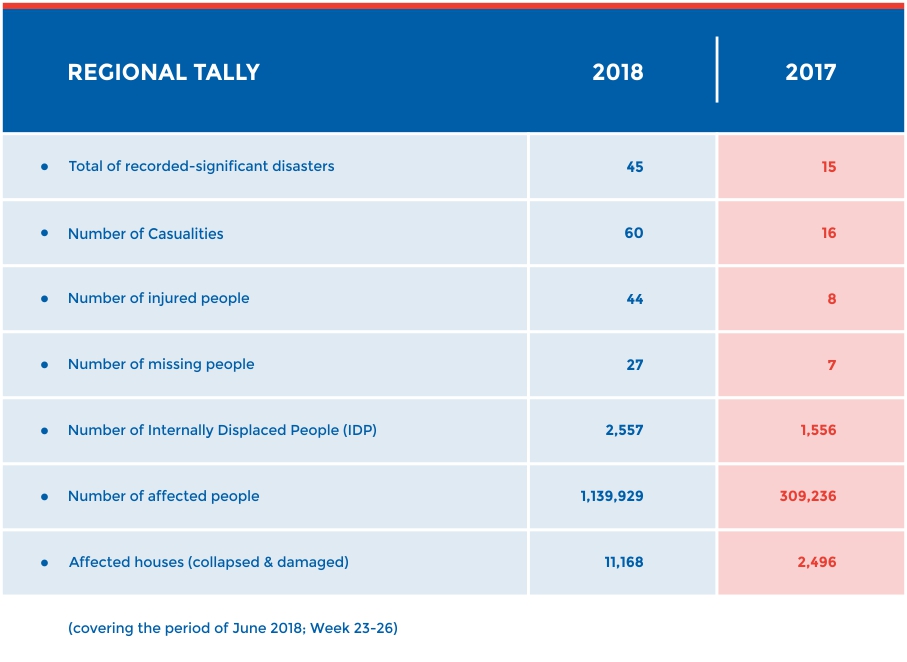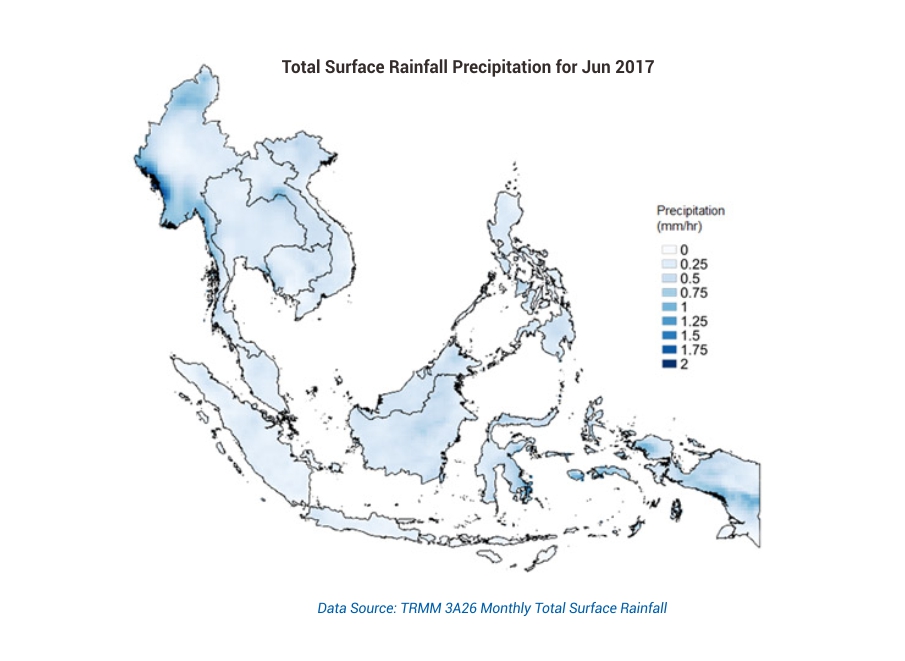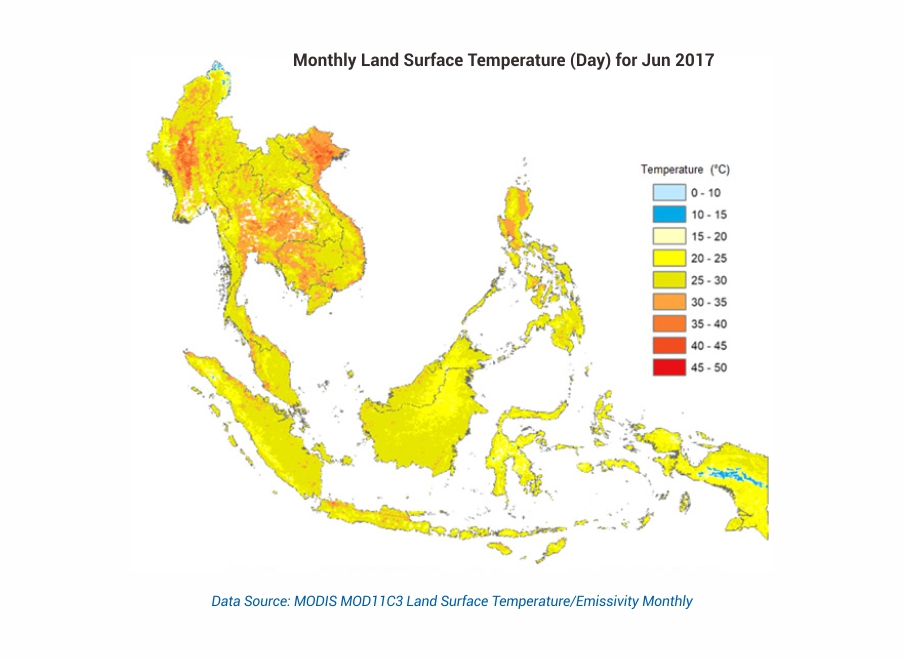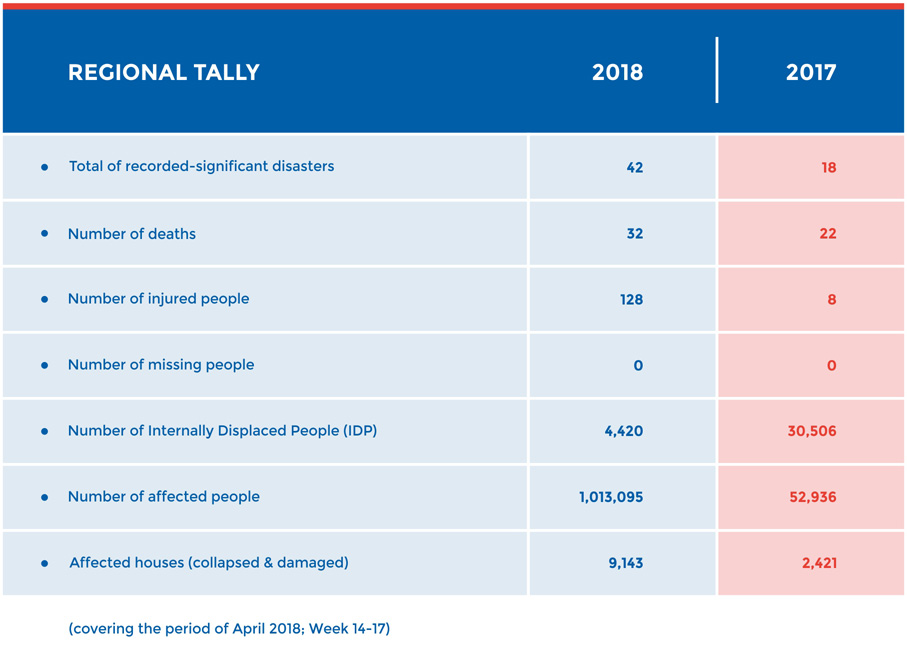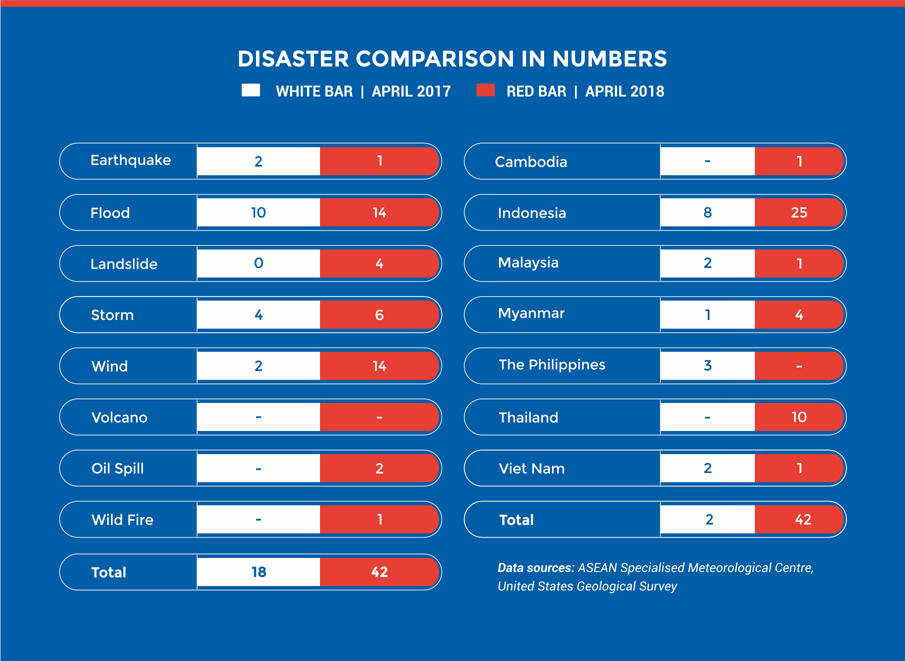Vol 42-ONE ASEAN ONE RESPONSE for Lombok

ONE ASEAN ONE RESPONSE
FOR LOMBOK
During August 2018 the AHA Centre once again evidenced ASEAN’s solidarity for disaster-affected population in the Southeast Asian region, this time supporting communities in the well-known tourist destination of Lombok, West Nusa Tenggara, Indonesia. The area was recently the epicentre of multiple earthquakes, with the initial major quake recorded at M 6.4 on Sunday the 29th of July. A week later, on the 5th of August, a larger M 7 earthquake hit the already-affected area, increasing numbers of casualties and causing greater damaged to buildings and livelihoods within the Lombok region. The main shock also triggered a tsunami warning, which thankfully did not result in an actual tsunami event. However, throughout the month of August, over 1000 aftershocks were recorded by the Meteorological, Climatology, and Geological Agency of Indonesia (BMKG), with the region still remaining vulnerable to quakes during the ongoing recovery phase.
Following the main earthquake on the 5th of August 2018, the AHA Centre intensified its cooperation with Indonesian National Disaster Management Authority (BNPB), which had been ongoing since the initial quake in late July. Upon receiving notification of the second earthquake, the AHA Centre immediately deployed a staff member to the field, provided information management and translation support for BNPB, as well as facilitated the deployment of an ASEAN Emergency Response and Assessment Team (ERAT) to the affected region. A little later, the AHA Centre obtained a green-light to mobilise relief items from the ASEAN emergency stockpile in Subang, Malaysia. These relief items – worth approximately USD $154,438 – were picked-up by the BNPB using a chartered flight, arriving in Praya Airport, Lombok, in three batches between early to mid-August.
For Lombok, earthquake events are not particularly new, with notable earthquakes recorded in the region from as early as the year 1856. Consolidated data from the United States Geological Survey and the Indonesian Meteorological and Climatology Agency (BMKG) also noted that major earthquakes above M 6 occurred on the island in 1970, 1972, 1978, 1979, and 2000. Based on the latest National Disaster Risk Index – published by BNPB in 2016 – Lombok is categorised as a medium to high-scale earthquake-prone area. Considering these vulnerabilities and risks, the resettlement areas currently underconstruction will use similar earthquake-resistant technology that has been adopted through the post-earthquake recovery periods in Aceh and Nias, Sumatera, Indonesia.
“Indonesia is part of the ASEAN community, and the BNPB has been working closely with the ASEAN coordinating agency for disaster management, or AHA Centre. All Heads of State and Government of ASEAN countries have agreed to stand as one, whenever natural disasters happen in neighbouring states. Based on the One ASEAN One Response Declaration, Indonesia trusts the AHA Centre to provide additional logistical support that is required for the emergency response. For example, this Mobile Storage Unit we stand in that can serve as a portable warehouse, and family tents that can provide shelters for the displaced communities”, said H.E Willem Rampangilei, the Chief of BNPB, in between the emergency responses in Lombok.
On a similar note, the Executive Director of the AHA Centre, Ms. Adelina Kamal, stated that “the ASEAN relief items belong to all ASEAN countries, including Indonesia. When a disaster occurs and relief items are required, ASEAN Member State can access the regional stockpile, and the AHA Centre will facilitate its mobilisation to the affected areas. We would like to show our appreciation to the BNPB for the confidence given to the AHA Centre in complementing the government’s life-saving efforts on the ground. Our partnership strengthens the vision embodied in the ASEAN Declaration on One ASEAN One Response”.
All ten ASEAN Member States have recognised the AHA Centre as the primary regional disaster management coordinating agency in ASEAN. Indonesia has been actively involved in the establishment of the AHA Centre, and has been hosting the AHA Centre since it first opened in November 2011. The mission to Lombok is the AHA Centre’s fifth response this year, bringing the total responses to 23 emergencies in 7 ASEAN countries since the AHA Centre’s establishment.
Written by: Shintya Kurniawan | Photo : AHA Centre
- Published in Highlight
Vol 40-Monthly Disaster Review and Outlook

MONTHLY DISASTER REVIEW AND OUTLOOK
JUNE 2018 | DISASTER MONITORING & ANALYSIS
(DMA) UNIT, AHA CENTRE
GENERAL OVERVIEW OF JUNE 2018
There was a three-fold increase in the number of disasters recorded during June 2018 (45 in total) in comparison to the same time during 2017 (15 disasters). An onset of numerous weather events caused this spike in disasters, with the southwest monsoons, Tropical Depression (TD) Domeng, TD Ewiniar, TD Ester and TS Florita causing floods and landslides throughout the Philippines, Viet Nam and Myanmar. In contrast, several areas south of the equator, particularly Indonesia’s Central Java and Yogyakarta provinces, have experienced the onset of drought conditions, consistent with the shift to the region’s dry season. This such phenomena indicates a similar pattern to 2017, which saw northern parts of ASEAN experiencing wet season floods, while southern parts experienced dry season drought events (see Figure 1) . Overall, 20 flood events, 11 storms and 4 wind-related disasters were recorded throughout June 2018.
In terms of geological hazards, 26 earthquakes registering ≥ M 4.5 were observed across Indonesia and the Philippines. However, only two were strong enough to cause property damage (East Java and Papua provinces of Indonesia, on the 13th and 15th of June respectively. Towards the end of June 2018, concerns were raised due to increased activity reported on Bali’s Mount Agung, which released ash plumes and resulted in a strombolian-type eruption.
OUTLOOK FOR JULY-AUGUST 2018
According to the ASEAN Specialised Meteorological Centre (ASMC), most parts of the ASEAN region will continue to experience wet weather, as the rain band associated with Typhoon Prapiroon affects the region. Hotspot activities have remained subdued, but isolated events have been detected in Viet Nam and Lao PDR. During the first week of July, dry weather is expected to affect Java, and may exacerbate the ongoing drought events. Aside from such southern areas, wet weather is likely to persist over other parts of the ASEAN region. For tropical cyclone (TC) forecasts, the Philippine Atmospheric. Geophysical and Astronomical Services Administration (PAGASA) expects that 10-14 TCs will form and enter the Philippine Area of Responsibility throughout the six months between July and December 2018.
Close and continuous monitoring is still required for Mount Sinabung (Alert Level IV) and Mount Agung (Alert Level III) in Indonesia, particularly due to historic Mount Agung eruptions, which lasted up to one year during 1963-1964.
Written by : Mizan Bisri, Qing Yuan Pang
DISCLAIMER
AHA Centre’s estimation is based on data and information shared by National Disaster Management Organisations (NDMOs) and other relevant agencies from ASEAN Member States, international organisations and news agencies. Further information on each recorded-significant disaster, description and details of data and information are available at: http://adinet.ahacentre.org/reports.
- Published in Monthly Disaster Outlook
Vol 38-Monthly Disaster Review and Outlook

MONTHLY DISASTER REVIEW AND OUTLOOK
APRIL 2018 | DISASTER MONITORING & ANALYSIS
(DMA) UNIT, AHA CENTRE
GENERAL OVERVIEW OF APRIL 2018
Flood and wind-related disasters had by far the highest number of occurrences during April 2018. ASEAN should remain prepared as changes in seasonal and weather patterns occur, increasing the probability and varying impact of hydro-meteorological disasters. According to the ASEAN Specialised Meteorological Centre (ASMC), the northern ASEAN region continued through its traditional dry season, while wetter conditions were experienced in the south of the region, as the monsoon through and its associated rain-band settled close to the Equator. Hailstorms were a notable phenomenon last month in Lao PDR and North-Eastern Thailand, resulting in adverse impacts on power lines, infrastructure and agriculture.
22 moderate-to-strong earthquakes (> M 5.0) were observed across Indonesia, Myanmar and the Philippines during the month, causing minor disruptions locally, but without significant humanitarian impact. One notable event was the M 4.4 earthquake reported in Banjarnegara, Indonesia, with the shallow quake centre and the area’s loose soil conditions causing severe damage to 465 houses (57.8% suffered partial to total collapse).
Technological disasters also took place during April, most notably a range of landfill fires in Myanmar that threatened the health and livelihoods of significant numbers of residents in nearby areas. Significant numbers of people were affected by fumes resulting from these fires, with residents living close to the landfill site experiencing the worst conditions. Starting on the 21st of April, smoke from the fires covered 20 townships across Yangon, with an increased likelihood of adverse health effects – particularly for children and the elderly – experienced by almost 800,000 people within a 30 km radius of the fires.
OUTLOOK FOR MAY-JUNE 2018
The region is expected to gradually transition from the current Northeast Monsoon conditions, to the inter-monsoon conditions in May 2018 – in which low-level winds in the region are generally light and variable in direction, with an increase in shower activities to be expected. Some parts of the northern ASEAN region may continue to experience dry conditions in May 2018, but are likely to ease off with an increase in shower activities as the inter-monsoon period takes hold. For the southern ASEAN region, shower activities are expected over most parts of the area.
For the rest of the April-May-June 2018 season, the northern ASEAN region is likely to experience near-normal rainfall levels, aside from coastal areas of the Andaman Sea and the Philippines, where there is an increased chance of above-normal rainfall. In the southern ASEAN region, slightly below-normal to near-normal rainfall can be expected.
Written by : Mizan Bisri, Qing Yuan Pang
DISCLAIMER
AHA Centre’s estimation is based on data and information shared by National Disaster Management Organisations (NDMOs) and other relevant agencies from ASEAN Member States, international organisations and news agencies. Further information on each recorded-significant disaster, description and details of data and information are available at: http://adinet.ahacentre.org/reports.
- Published in Monthly Disaster Outlook

